Contents
Most gardeners grow peppers in seedlings, paying maximum attention and taking care of a small plant. It often takes a lot of time and effort to grow strong, healthy seedlings. However, not all farmers carry out the care of peppers after planting in the ground correctly, making mistakes that affect crop yields. So, in order for all the efforts to care for seedlings not to be in vain, you should clearly know and follow all the rules below.

Peppers in the open field
With the onset of truly warm summer days, it is worth thinking about planting seedlings. So, peppers can be planted in open ground starting from the end of May. In some northern regions, planting should be postponed until the tenth of June. By this time, the plants must be hardened, preparing for new conditions.
Site selection and soil preparation
Peppers are heat-loving plants that require high humidity. They do not tolerate strong winds and constant drafts, therefore, for planting seedlings, a sunny plot of land on the south side should be allocated. Wind protection for peppers can be natural, stationary, for example, the wall of a building, or artificially created by planting tall plants. Decorative fences or wattle fences can also be man-made wind protection.
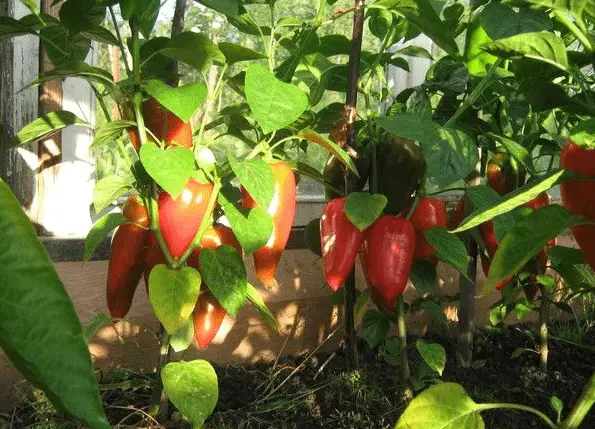
As with any cultivated plant, there are good and bad predecessors for pepper. You can plant plants in the soil where legumes, pumpkin crops, and root crops previously grew. For growing in close proximity to peppers, you can pick up “good neighbors”. So, onions, leeks and carrots will help the pepper grow better. The “bad neighbor” for pepper is the tomato. The plant is neutral to other crops.
For growing peppers, you should choose a well-drained, fertile soil. It is better to prepare it in the fall. To do this, it is necessary to remove the remains of vegetation and dig up the earth. During digging, organic matter (humus, manure) should be added to the soil. The recommended consumption of organic fertilizer is 5-10 kg/m2. Wood ash and superphosphate (50 g of each substance) should be added to the same area of uXNUMXbuXNUMXbthe earth.
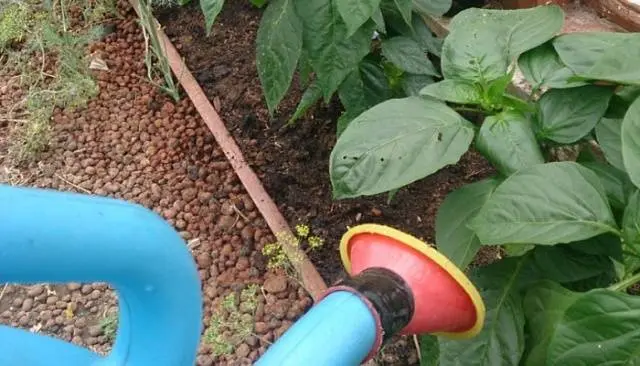
The manure introduced into the soil in the fall will successfully perepreet. The concentration of nitrogen in it will decrease, and the composition of organic matter will become more gentle. It is impossible to introduce fresh manure in the spring before planting seedlings, as this can destroy the plants.
A piece of land prepared, dug up in the fall, is loosened in the spring. Phosphorus and potash fertilizers are added to the soil, in a volume of approximately 30 g / m2, after which the soil is leveled with a rake.
The site prepared in this way will be an excellent springboard for growing plants in open ground. Organics will not contain aggressive nitrogen. As it decomposes, it will warm the roots of the peppers and preserve the plants even in adverse weather conditions. Potassium and phosphorus introduced in the spring will allow the seedlings to take root better and transfer the planting painlessly.
Transplanting
It is necessary to plant peppers in open ground after the threat of frost has already passed. In most regions of the country, this time falls at the end of May. Before planting, the plants must be watered abundantly, so that the soil does not crumble during planting, remaining in a lump in the vine.
It is recommended to plant seedlings after sunset or in cloudy weather. The absence of heat and direct sunlight will allow plants to better adapt. It is necessary to plant seedlings in compliance with distances that depend on the tallness of the variety. So, standard, undersized peppers, up to 60 cm high, are planted 4 pcs / m2. Seedlings of tall varieties are planted 2 bushes per 1 m2 of the soil.
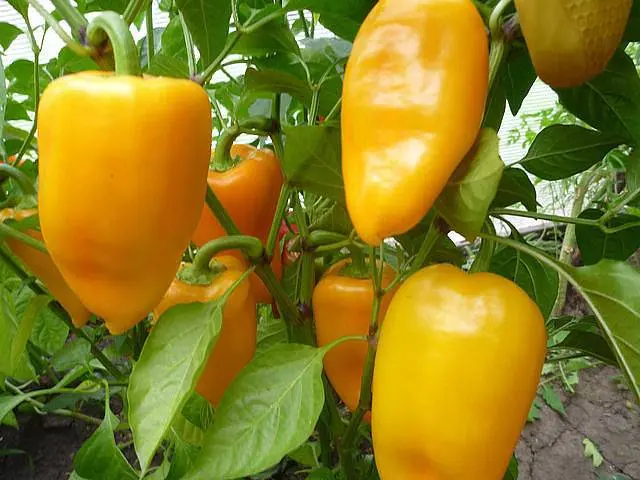
Having marked the beds, taking into account the necessary distances, it is necessary to make holes, and then water them. Water consumption for such irrigation should be 1 liter per 1 well. In this case, it is better to use rain warm water. After the liquid has been absorbed, you can proceed directly to the planting of peppers. To do this, you need to thoroughly knead the container in which the seedlings are located, then carefully, keeping the ground on the vine, remove the pepper and place it vertically in the hole. The depth of embedding should be such that the cotyledon leaves are in the ground. Subsequently, roots form on the part of the trunk that is embedded in the ground. They will help the pepper to take more nutrients from the soil.
Protection from cold and heat
It is possible to plant peppers in open ground ahead of schedule, but in this case the plants will have to provide additional protection from cold and frost. To do this, you can build a temporary greenhouse or tent. In this case, polyethylene, cardboard, burlap, old carpets and even roofing material can serve as a covering material. You can raise the material above the plants with the help of wooden blocks. In this case, special attention should be paid to the reliability of the design in order to avoid damage to plants. Temporary shelter will keep the earth warm at night. During the day, the greenhouse must be opened.
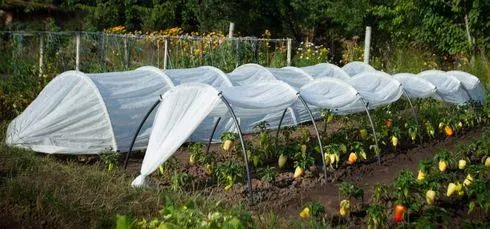
It often happens that in warm, favorable weather, the forecast of frost is a complete surprise. There is no time to install a greenhouse, but you need to protect the plants. In this case, you can resort to the “grandfather” method of smoking. So, not far from the landings, it is necessary to make a fire. For combustion, it is better to use strongly smoking materials, for example, roofing material. Puffs of thick smoke will be an excellent temporary protection against frost.
There is another long-proven method of protecting plants from unexpected frosts – sprinkling. For its implementation, you need to have a sprinkler (sprinkler). It is placed directly at the bed with peppers. Small drops of water have a positive temperature, over +100C. By irrigating the plants in this way all night, they can be prevented from freezing.
Excessively high air temperatures can also harm peppers. If stable weather is established with a temperature of + 30- + 350C, then in a few days the pepper flowers will fall off. This is primarily due to excessive evaporation of moisture and the consumption of nutrients. You can correct the situation with regular, plentiful watering.
Watering
Peppers are very fond of the increased humidity of the soil and air, and if a person cannot influence the parameters of the atmosphere, then it is not at all difficult to provide the necessary soil moisture. Regularity and abundance of watering are essential conditions for growing peppers. So, immediately after planting, the plants should be watered 1 time in 2 days. Water consumption should be approximately 1-2 liters per seedling. Watering should be carried out under the root of the plant.
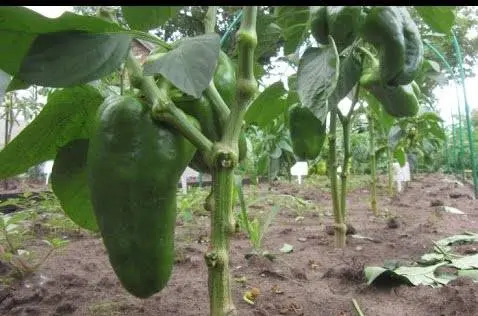
Two weeks after planting seedlings, plants should be watered rarely with small portions of water. This will allow the plant to abundantly form ovaries. Also, “thin” watering favorably affects the taste of the vegetable. At the same time, during the harvest, peppers should be watered 1 time in 5 days abundantly. Compliance with watering conditions allows you to grow delicious, fleshy, juicy peppers.
Weeding and loosening
For normal cultivation of peppers, you need to carefully monitor the soil. It should be loose and free from weeds. When loosening, the soil is saturated with oxygen, which allows peppers to grow quickly. Also, the presence of oxygen in the soil allows beneficial microorganisms to intensify their activity, warming the plants and protecting them from diseases.
It is worth noting that after planting, peppers stop growing for about 2 weeks. Some gardeners at the same time try to speed up the growth process by loosening the soil. This method is erroneous, because during this period the root system of plants is not adapted and loosening can harm it. That is why the first loosening of the soil must be carried out no earlier than 2 weeks after planting.
Pepper has a developed root system, which is located in the upper layers of the soil. In order not to damage the roots, it is necessary to loosen the soil superficially, without going deeper than 5-7 cm. However, heavy, clay soils require deeper loosening, up to 10 cm deep.
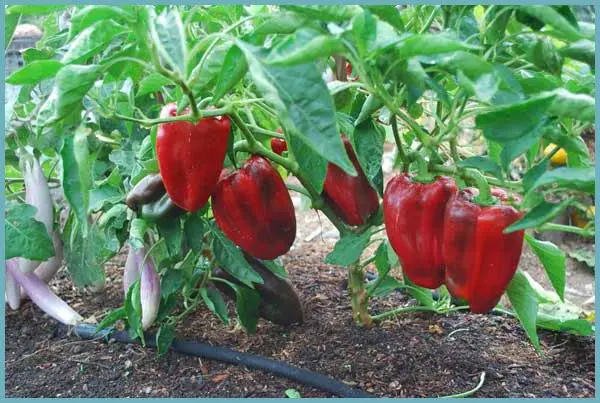
In general, the regularity of loosening depends on the composition of the soil. You can understand the need for loosening when a hard, earthy crust is found. So, you need to loosen the soil quite often: after heavy rain, several waterings.
Weeding peppers should be regular. Moreover, weeding should be done not only in the beds, but also in the aisles, since the roots of plants can be located in close proximity to them. Loosening, in turn, is a preventive measure that allows you to deal with weeds.
Additional fertilizing
It is necessary to feed peppers 3 times during the entire growing period. As plants grow, they consume more and more micronutrients, impoverishing the soil. That is why 3-4 weeks after planting the seedlings, you need to feed the peppers for the first time. To do this, you can use special ready-made fertilizers or organics with the addition of minerals. Slurry is the most common top dressing in rural areas. The manure solution will bring additional benefits to peppers if mineral fertilizers with phosphorus and potassium are added to it. Wood ash can also be a useful additive.
The second top dressing should be carried out 3 weeks after the initial fertilization. In this case, you can use the same manure infusion or infusion of bird droppings. The third top dressing must be planned for the period of active fruiting. At this time, peppers consume a lot of minerals, including nitrogen, which can be added in the form of ammonium nitrate.

Thus, peppers can be successfully grown outdoors and still get a good, plentiful harvest of tasty, large fruits. An example of such cultivation is shown in the video:
Features of growing peppers in a greenhouse and greenhouse
Greenhouses and greenhouses are used for growing peppers not only in the northern regions, but also in warmer areas. They allow you to get an early harvest of vegetables, protect plants from spring frosts, temperature fluctuations at night and daytime, and the vagaries of summer weather. Growing indeterminate peppers in greenhouses can significantly extend their fruiting period. Thus, the greenhouse is a unique structure that allows you to artificially create a favorable microclimate for peppers and increase plant yields.
Greenhouse preparation
One of the most significant drawbacks of protective structures is the accumulation of harmful insects, their larvae and fungi. It is necessary to get rid of pests in the spring, a week before the proposed planting.
Aphids, slugs, and other pests can hide in parts of the protective structure. That is why in the spring it should be processed:
- a greenhouse made of polycarbonate or glass must be washed with soapy water;
- clean the wooden frame of the greenhouse from dirt and treat with copper sulphate, dissolving it in water in a ratio of 1:10. Additionally, wooden structural elements are recommended to be whitewashed with lime;
- processing of metal parts of the shelter must be carried out by dousing with boiling water.
When cleaning in a greenhouse, it is necessary to remove all the remains of former plants, as well as moss and lichen.
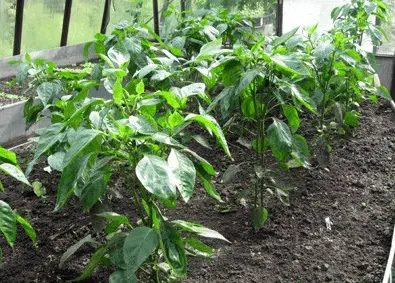
For the final victory over pests, you can resort to smoking with lump sulfur. To do this, you can use special smoke bombs or the substance itself, decomposed on sheets of iron. When igniting a substance, it is necessary to take care of personal protective equipment, since the gases released during the combustion of lump sulfur are harmful not only to insects, but also to humans.
It should be noted that smoking will be effective only if the room is relatively airtight, has no through holes and open windows. After the procedure, the greenhouse must be closed for 3-4 days. After such treatment, you can safely plant pepper seedlings without fear that voracious pests will encroach on it.
Soil Preparation
The bulk of parasites and fungi live in the top layer of soil, so the soil in the greenhouse should be completely changed regularly or replaced at least the top 10 cm of soil. A new layer of soil for growing peppers must be sieved, mixed with well-rotted organic matter and mineral trace elements. You can also kill pest larvae and fungi in the soil by spilling a manganese solution or boiling water.
Transplanting
You can plant seedlings of peppers in a greenhouse at a time when the soil is warmed up to a temperature of +150C. Such conditions in central Our Country can be expected in early May. For even earlier planting of plants, greenhouses can be equipped with a heating system. In this case, peppers can be planted at the end of March.
Immediately before planting peppers, it is necessary to introduce a certain amount of phosphorus and potash fertilizers into the soil, and then loosen the soil surface with a rake. Plants should be planted in the evening hours, after the atmospheric temperature drops. On the eve of the day of disembarkation, peppers should be well watered.
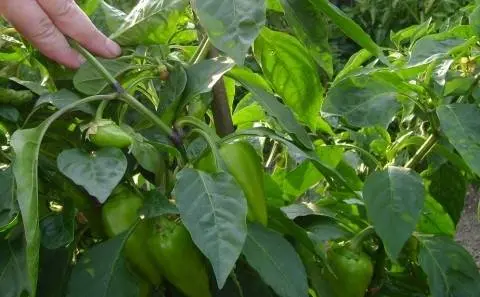
Young plants should be planted in beds no more than 1 m wide. The distances between seedlings depend on the tallness of the plants. So, undersized peppers in a greenhouse can be planted at a distance of 20 cm from each other, tall giants are recommended to be placed no closer than 40 cm from each other. When planting, the cotyledon leaves of pepper should be at ground level. The soil in the root zone of the plant must be compacted and mulched.
Basic care
Caring for peppers after planting in a greenhouse is not much different from caring for plants in the open field. So, the first time after planting, regular, plentiful watering should be carried out. Insufficient moisture will reduce the yield of plants and make the fruits small, “dry”. You can keep moisture in the soil and reduce the need for watering by mulching the soil.
Pepper in a greenhouse can grow at temperatures from +230C to + 300C. At the same time, exceeding the indicator can negatively affect the process of formation of ovaries. You can regulate the temperature by ventilating the greenhouse and watering the plants. You can also cool the plants by sprinkling. At the same time, closing the room at night, you can save daytime heat and minimize temperature fluctuations, which favorably affects the growth of peppers.
Pepper is picky about high humidity. So, the optimal value of this indicator is 70-75%. You can create such a microclimate by installing water containers in the greenhouse.
By feeding the pepper, you can accelerate its growth and improve the quality of the fruit. So, pepper in a greenhouse should be fed twice: the first feeding should be carried out during flowering, the second during the period of active fruiting. You can use slurry, bird droppings, urea solution to fertilize peppers. Complex mineral fertilizers for feeding peppers can be applied additionally in a small amount, about 1 time per month.
Shrub formation
Regardless of the conditions in which pepper is grown, whether it be open or protected ground, plants must be formed during the growing season. This will allow the plant to grow a large number of lateral fruit-bearing branches and, as a result, increase productivity.
The principle of plant formation depends on its tallness:
- On peppers of tall varieties, side shoots should be partially removed and the top of the plants should be pinched;
- On peppers of medium height varieties, the lower and barren side shoots are removed. This thinning allows air to circulate better. This is especially important when growing peppers in protected ground, where plantings are quite dense, and there is no natural air movement. Such conditions can contribute to the development of diseases, and pruning plants prevents this problem.
- Low-growing peppers do not need pruning at all.
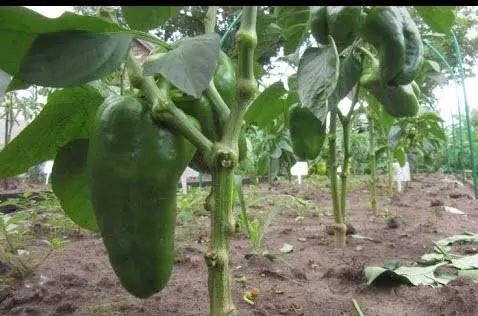
When forming plants, the following rules should be remembered:
- flowers that form at the branching point of the pepper must be removed for the further normal development of the plant;
- a properly formed pepper bush has only 2-3 main, strong, fruiting shoots;
- shoots that do not form fruits must be removed, they uselessly consume the energy of the plant;
- it is possible to accelerate the ripening of fruits with the approach of autumn by pinching the main fruit-bearing shoots.
A properly formed plant will not take up much space, but at the same time it will provide high yields. Useless shoots should not be spared, because they consume nutrients that should be used to form fruits.
Conclusion
Thus, caring for pepper is quite simple. To do this, you need to know the basic requirements of the plant and in every possible way contribute to the creation of favorable conditions. Nutritious soil, high humidity and moderate, regular watering are the determining factors in the process of growing pepper. Also, do not forget about the formation of the plant, fertilizing, weeding, loosening and mulching the soil. The complex of all these activities, of course, requires time and effort, however, the grateful return of the crop in this case will not take long.









